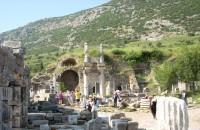
Ephesus Archaeological Site: Domitianus Temple, seen from the Street of the Curetes
The Street of the Curetes starts at Prytaneion and leads to the Library of Celsus past the Domitianus Square and Temple. At the end of the street there used to be two marble figures of Hermes. The Domitianus temple is rectagular and on three bases there were 3 statues in coves joined with arches. The statues depicted Memmius, his father Gaius and his Grandfather Syllas.
The temple it self was with a portico in antis (prostyle) and raised, since the stylobates were at a height of eight steps. |To the east there was the shrine (today in the Ephesus Museum) and tha statue of the emperor, of a total (inclusive the base) height of 7 meters (21 ft). The statue was found in pieces; its haed and its hand are also in the museum. |
|
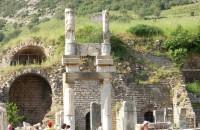
Ephesus Archaeological Site: Domitianus Temple (Detail) |
|
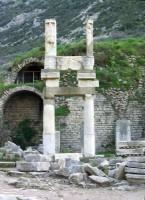
Ephesus Archaeological Site: The Temple of Domitianus (Detail) |
|
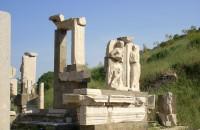
Ephesus Archaeological Site: The Monument of Memmius
1st century BC |
|
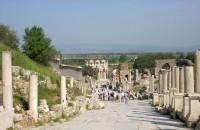
Ephesus Archaeological Site: The Street of Curetes
In the background the Library of Celsus. Midway to the right, the Square and Temple of Domitianus, shown in the previous photos. |
|
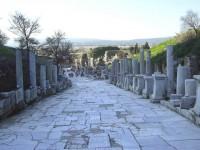
Ephesus Archaeological Site: The Street of Curetes
The sun is setting and the street is shaded; the only sunlit complex is the Temple of Domitianus, in the background. |
|
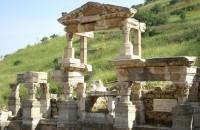
Ephesus Archaeological Site: Trajanos Fountain (102-104 AD)
Partially preserved. It is 12 m (36ft) high and located on the way from Memmios Monument to the Temple of Domitian. It was closed on its three sides with a wall, the façade was imposing, decorated with two-storied columns. Behind the columns, in niches, there were statues of Dionysus, Aphrodite, Satyrs and of the members of the imperial family. There is a carved sign where Ephesus is called 'Neokoros' (temple warden), meaning it was awarded the important priviledge of being allowed to build temples in the honor of the emperors, an honor to be cherished by Smyrna, Pergamum and Trallis. |
|
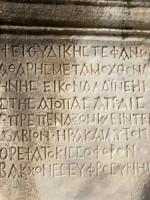
Ephesus Archaeological Site: Stele with text carved in Greek |
|
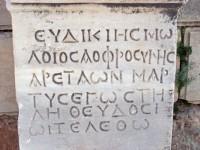
Ephesus Archaeological Site: Stele with text carved in Greek |
|
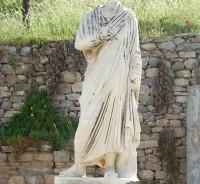
Ephesus Archaeological Site: Statue of Alexander, Doctor of Alexander (the Great?) |
|
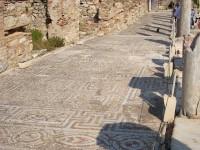
Ephesus Archaeological Site: Mosaic Paved Road in front of Hadrian's Temple |
|
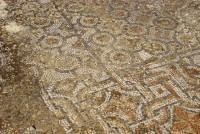
Ephesus Archaeological Site: Mosaic Paved Road in front of Hadrian's Temple (Detail) |
|
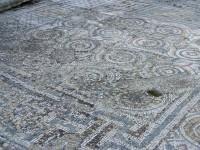
Ephesus Archaeological Site: Mosaic Paved Road in front of Hadrian's Temple (Detail) |
|
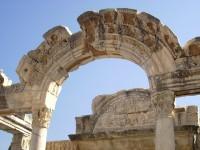
Ephesus Archaeological site: Hadrian's Temple Small Gate (138 AD)
The façade of the temple has four Corinthian columns supporting a curved arch, in the middle of which contains a relief of Tyche, goddess of victory. The side columns are square (not visible in the photo). On both sides there are friezes depicting the story of the foundation of Ephesus. (They are actually copies of the originals). The Medusa is visible on the inner gate, in the background |
|
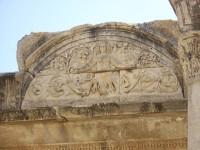
Ephesus Archaeological site: Hadrian's Temple Small Gate
The figure of Medusa above the inner gate. She was supposed to have snakes for hair and she would petrify anyone who would see her face! |
|
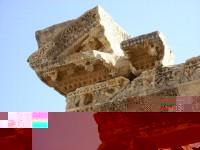
Ephesus Archaeological site: Hadrian's Temple Small Gate |
|
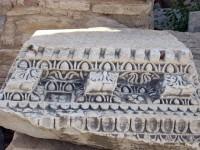
Ephesus Archaeological site |
|
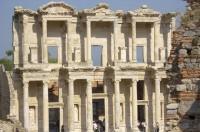
Ephesus Archaeological site: The Library of Celsus
Built in the first half of the 2nd century AD (110AD). Restored in 1978. |
|
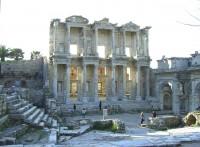
Ephesus Archaeological Site: The Library of Celsus |
|
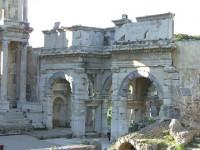
Ephesus Archaeological Site: The Library of Celsus |
|
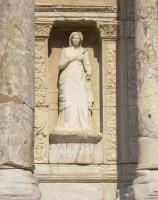
Αρχαιολογικός Χώρος Εφέσου: Αντίγραφο του Αγάλματος "ΑΡΕΤΗ ΚΕΛΣΟΥ" στη θέση του σε φατνίο της πρόσοψης
Το πρωτότυπο, μαζί με τις άλλες τρεις "Αρετές" του Κέλσου εκτίθεται σήμερα στο Μουσείο της Εφέσου στη Βιέννη, όπου μεταφέρθηκαν μετά τις ανασκαφές τού 1911 (όχι, θα τα άφηναν!), στο μνημείο βρίσκονται τα γύψινα εκμαγεία τους ("προσφορά" του μουσείου που κρατά τα πρωτότυπα) |
|
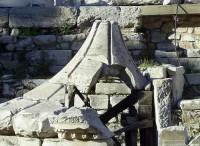
Ephesus Archaeological Site
Roman well with its protective cover. There is also a mechanism for pulling up water. |
|
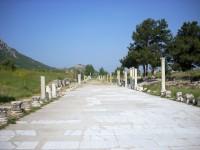
Ephesus Archaeological Site: The Road to the Port (Arcadian Street)
In ancient times Ephesus used to have direct access to the sea. Now, it is far away from it because of the sedimentation of the debris carried by the river Kaistros or Astreos (today called Small Meander).
The road is used as parking space today, whenever performances take place at the local theater (please look at the following photos). |
|
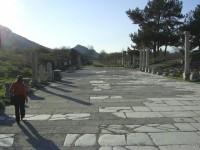
Εphesus Archaeological Site: The Road to the Port, in the afternoon |
|
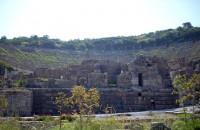
Ephesus Archaeological Site: The Theater
It used to be smaller in Classical Times, but it had many seats added during the Roman Times. |
|
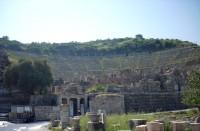
Ephesus Archaeological Site: The Theater and its Entrance |
|
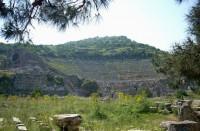
Ephesus Archaeological Site: The Theater from afar |
|
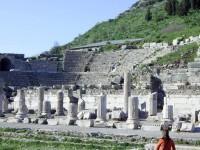
Ephesus Archaeological Site: The Theater from closeby |
|
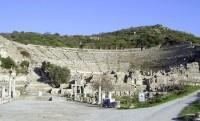
Ephesus Archaeological Site: The Theater |
|
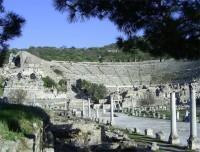
Ephesus Archaeological Site: One more photo of the Theater |
|
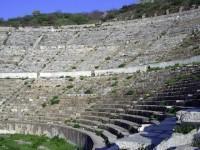
Ephesus Archaeological Site: The Theater photographed from the inside |
|
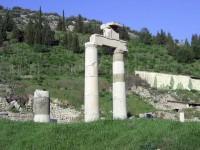
Ephesus Archaeological Site: The Prytaneion
The Prytaneion was where the Prytanes had his head-office. He was elected among the rich inhabitants of the city, administered only his personal funds and he was responsible of taking good care of the Eternal Fire in the honor of Goddess Artemis (Diana), kept within the Prytaneion. He was also organizing and in charge of all public holy ceremonies.
The statues of Artemis excavated in the Prytaneion are exhibited at the Ephesus Archaeological Museum. |
|



